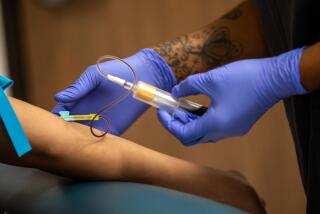Gonorrhea Rate Drops 36% in County in Year
- Share via
The rate of gonorrhea in Orange County has dropped sharply--down 36% from last year--in part because of county treatment of prostitutes in jail, an aggressive statewide effort with a new antibiotic and the fear of AIDS, county health officials said this week.
“Some prostitutes are saying they’re being more careful” because of the AIDS threat, said Dr. Rick Greenwood, manager of the county’s communicable disease treatment program. He noted that several prostitutes who were arrested recently were carrying condoms.
Gay men, also increasingly worried about acquired immune deficiency syndrome, appear to have moderated their sexual practices, and more are reporting using condoms, Greenwood and other county health officials said.
More Pronounced Decline
In California and across the country, the rate of gonorrhea has also declined. But the decrease in the county this year appears to be more pronounced than elsewhere, county and state health officials said.
In Orange County, gonorrhea cases decreased from 5,294 cases through November, 1986, to 3,387 cases through November, 1987.
Although the number has declined steadily since 1979, when there were 7,575 cases, the 36% drop this year was more dramatic than in previous years, county health officials said. Last year, for instance, gonorrhea cases decreased just 13%.
Statewide, gonorrhea cases decreased 28%--from 118,064 in 1986 to about 84,800 in 1987, according to the most recent state statistics available.
Warning on Conclusions
Nationally, gonorrhea cases dropped 7% from June, 1986, to June, 1987, said Kathleen Toomey, a scientist for the National Centers for Disease Control in Atlanta.
Although Toomey said she was impressed with the county’s declining rate, she warned against concluding that AIDS education was leading to safer sexual practices everywhere.
“We’ve lulled ourselves into thinking that AIDS prevention is lowering the risk of sexually transmitted diseases,” which may not be true in some areas of the country, she said.
But in Orange County, officials noted that the gonorrhea rate had dropped sharply in 1987 in all ethnic groups, decreasing 44% among whites, 28% among blacks, 34% among Latinos, 5% among Asians and 73% among Indochinese.
Greenwood and other county officials cited these reasons for the drop:
Strong fears about AIDS, which may be leading to more condom use and generally safer sexual practices among gay men.
Along with the declining gonorrhea rate, Greenwood reported that the cases of gonorrhea proctotis, a rectal disease once common among gay men, had “dropped off to zero” at the county clinic for sexually transmitted diseases.
In addition, Latino men are telling community educators that they insist on using condoms with a prostitute, said Raoul Magana, supervisor of the county’s 2-year-old, $200,000 AIDS education project.
Still “you have to take that with a grain of salt,” Magana cautioned. “You don’t know if they’re telling you that to please you.”
A new treatment program for prostitutes at the county jail. In 1987, about 1,700 prostitutes received information about AIDS, along with physical examinations and treatment for venereal disease, county health officials said.
An aggressive local and statewide effort to treat penicillin-resistant gonorrhea with an expensive new antibiotic, Rocephen. About half of the 40,000 people who visited the county’s clinic for sexually transmitted diseases were treated with Rocephen, which destroys strains of gonorrhea resistant to penicillin or ampicillin.
Oddly, while gonorrhea cases declined, the reported cases of syphilis, another common venereal disease, rose slightly last year in the county and around the state, according to figures from the state Health Services Department.
Through November, 1987, the county had 525 syphilis cases, contrasted with 517 in all of 1986; statewide the number was about 11,000 in 1987, contrasted with 9,050 in 1986, state communicable disease specialist Jim Dobbins reported.
Health officials said they are not sure why gonorrhea cases would decrease while syphilis cases rose. But Orange County epidemiologist Thomas J. Prendergast noted that gonorrhea affects a broad population spectrum, whereas syphilis affects a narrower, “very-difficult-to-reach core of individuals” who have frequent contacts with prostitutes and intravenous-drug users.
Both diseases affect the moist surfaces of the sex organs and are spread by sexual contact. About half of the women infected with gonorrhea develop no symptoms, and both sexes may show no symptoms when infected with the latent stage of syphilis.
Syphilis can eventually cause blindness, heart disease and insanity. Gonorrhea can cause sterility in women and blindness in babies born to infected women.
More to Read
Sign up for Essential California
The most important California stories and recommendations in your inbox every morning.
You may occasionally receive promotional content from the Los Angeles Times.










